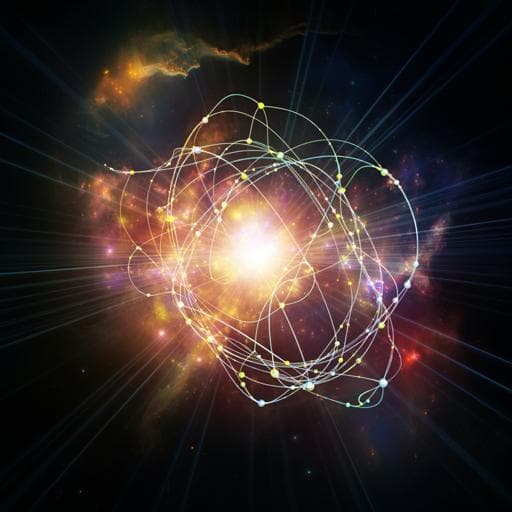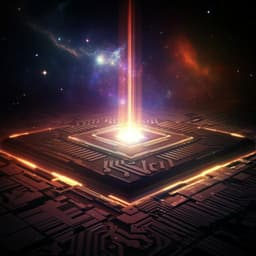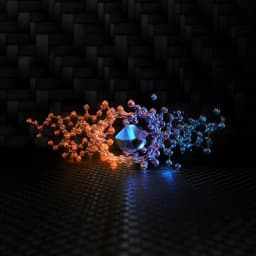
Physics
Hong-Ou-Mandel interference of single-photon-level pulses stored in independent room-temperature quantum memories
S. Gera, C. Wallace, et al.
This innovative study showcases the Hong-Ou-Mandel (HOM) interference phenomenon with single-photon-level pulses stored and retrieved from independent quantum memories. Conducted by Sonali Gera and colleagues, the research reveals that storage and retrieval processes maintain high HOM visibility, essential for advancing large-scale memory-assisted quantum networks.
~3 min • Beginner • English
Introduction
The study addresses a key requirement for type II quantum repeater networks: independent, room-temperature quantum memories (QMs) must store and retrieve photonic qubits without compromising indistinguishability across polarization, temporal, and spectral degrees of freedom to enable high-rate entanglement swapping. While type I (DLCZ) repeaters exist, their rates are limited. Type II architectures, which store photons from external entanglement sources into multiple in–out memories and perform Bell-state measurements (BSMs), can achieve higher rates when paired with fast sources and fast, room-temperature atomic memories. A critical benchmark for indistinguishability is Hong–Ou–Mandel (HOM) interference performed on photons retrieved from separate QMs. Prior demonstrations focused on type I settings; a type II absorptive memory-to-memory HOM demonstration had been lacking. This work demonstrates HOM interference between (i) few-photon-level polarization states stored in independent dual-rail warm 87Rb vapor EIT memories and (ii) single-photon-level pulses with fixed polarization stored in single-rail memories. It investigates how background noise impacts indistinguishability at the single-photon level and establishes a quantitative relationship between signal-to-background ratio (SBR) and HOM visibility, informing the design of scalable, room-temperature memory-assisted quantum networks.
Literature Review
The introduction situates the work within quantum internet development, highlighting entanglement distribution over long distances and the role of quantum repeaters. Type I repeaters (DLCZ) generate entanglement via interference of photons generated within quantum registers but have low rates. Type II repeaters store photons from external entanglement sources into multiple in–out memories and perform BSMs, enabling higher rates when interfacing fast sources with fast, room-temperature atomic memories. Prior experiments demonstrated HOM interference of pulses recalled from separate solid-state memories and interference of photons from remote emitters, as well as room-temperature QMs for polarization qubits and free-space quantum links. However, an explicit type II-style HOM interference between pulses retrieved from independent absorptive room-temperature QMs remained to be shown. The work also builds on literature about EIT-based warm vapor memories, sources of background (ASE, FWM, SRS), and techniques for noise suppression and compatibility with bright SPDC and quantum dot sources.
Methodology
Three experimental configurations were implemented using warm 87Rb vapor EIT quantum memories (QMs) operating on the D1 line in a Λ scheme with 400 MHz red detuning. The control field is tuned to F = 2 → F′ = 1 and the probe (signal) to F = 1 → F′ = 1. Dual-rail operation stores polarization qubits by mapping |H⟩ and |V⟩ components into two spatial rails using beam displacement optics (Gen I used calcite beam displacers; Gen II used a Sagnac-like implementation). Single-rail operation aligns the input polarization to one rail and blocks the other. After storage, polarization filtering attenuates the strong control field; rails are recombined, and frequency filtering (Fabry–Pérot etalons; Gen II used improved etalons and a Volume Bragg Grating) further suppresses control leakage. Gen II employed circular polarizations (σ+) for probe/control to reduce FWM and SRS.
- Sources: Two independent pulse sources (Alice and Bob) generate Gaussian pulses (200–400 ns FWHM) from the same laser; a phase modulator randomizes relative phase. Pulses are attenuated to few- or single-photon levels.
- Measurement station: A 50:50 non-polarizing beamsplitter combines the retrieved fields; single-photon counting modules record detections. Calibration without memories measured reference HOM visibilities by scanning polarization or temporal overlap.
- Experiment 1 (Gen I, dual-rail, few-photon polarization states): Two independent QMs stored 400 ns pulses in dual-rail configuration with 1 μs storage time. Mean photons at memory inputs: ~14 (Alice) and ~10 (Bob). Due to filtering and losses, memory-free transmission ~3%. Retrieved mean photons per stored pulse within a 0.5 μs ROI were ~0.024 (Alice) and ~0.017 (Bob). The relative polarization between retrieved pulses was scanned to observe HOM modulation in coincidences.
- Experiment 2 (Gen I, single-rail, single-photon level): Inputs had ~1.6 photons per pulse; storage efficiencies within ROI were ~7% (Alice) and ~18% (Bob). Fiber coupling was adjusted to equalize retrieved mean photon numbers at the beamsplitter inputs. Storage times were equal (0.9 μs), and relative temporal delay was scanned via retrieval timing. Coincidences were integrated over two 0.3 μs ROIs covering the retrieved pulses to isolate signal from background. Background-only runs (control on, probe off) quantified non-interfering noise.
- Experiment 3 (Gen II, single-rail, single-photon level with noise reduction): Noise mitigation included ASE filtering (Volume Bragg Grating, 50 GHz FWHM), improved etalons, σ+ polarizations, and other upgrades, yielding overall transmission ~20%. Inputs were 300 ns FWHM Gaussian pulses with ~1.6 photons per pulse. After storage/retrieval, mean signal per retrieved pulse at the beamsplitter inputs was ~0.01 (excluding background). HOM delay was implemented by varying relative storage times ΔT = TAlice − TBob with TAlice + TBob fixed at 4 μs. For each ΔT, coincidences were counted within selected temporal ROIs; by adjusting ROI size, SBR was varied (estimated range ~1.7 to 11.9). Background-only traces confirmed absence of HOM interference from noise.
- Modeling: A simple model relates HOM visibility V to SBR R by V = V0 f(R), where V0 is the no-background visibility (reference without memories). Fitting experimental data across ROIs yielded the effective asymptotic visibility achievable with memories and quantified the dependence of visibility on SBR.
- Additional details: Periodic polarization compensation via waveplates before the beamsplitter; coincidence windows up to 1 μs; calibration reference visibilities without memories were (42.1 ± 0.2)% for polarization scans (Gen I station), (42.4 ± 0.6)% for temporal scans (Gen I station), and (48.5 ± 0.5)% for Gen II station.
Key Findings
- Dual-rail, few-photon polarization HOM (Gen I): Retrieved polarization states exhibited HOM visibility V = (41.9 ± 2.0)%, statistically consistent with the no-memory reference (42.1 ± 0.2)%, indicating that storage/retrieval did not degrade indistinguishability. The non-stored leakage portions showed lower visibility V = (23.4 ± 0.9)% due to temporal/power mismatch.
- Single-rail, single-photon level (Gen I): With ~1.6 photons per input pulse and SBR ~2.6, HOM visibility decreased to V = (25.9 ± 2.5)% (reference without memories: 42.4 ± 0.6%). Background-only measurements showed no HOM interference, confirming noise as the visibility-limiting factor. Storage efficiencies within ROI were ~7% (Alice) and ~18% (Bob).
- Single-rail, single-photon level with noise reduction (Gen II): Noise mitigation improved SBR to 1.7–11.9 (depending on ROI). With ROI = 160 ns (SBR ~11.9), HOM visibility reached V = (42.9 ± 3.4)% with a no-memory reference of (48.5 ± 0.5%). Across ROIs, visibilities were 17.1 ± 0.8% (SBR ~1.6), 31.6 ± 1.1% (SBR ~5.0), 36.2 ± 1.3% (SBR ~7.8), and 42.9 ± 3.4% (SBR ~11.9), demonstrating a monotonic approach to the reference as SBR increased.
- Model of visibility vs SBR: Fitting V(R) to the measured data yielded an asymptotic maximum of ~45.5% for the memory-assisted system, slightly below the 48.5% reference without memories, attributed to small mismatches (efficiencies, mean photon numbers, polarization drifts). The background photons showed no second-order interference.
- Projection to polarization qubits: Accounting for an anticipated ~50% reduction in SBR when switching to dual-rail, the Gen II system is estimated to yield ~33% HOM visibility for polarization qubits under the same conditions.
Discussion
The experiments demonstrate that room-temperature EIT-based Rb vapor quantum memories can store and retrieve few-photon-level polarization states without degrading HOM visibility, validating phase stability and compatibility of dual-rail operation for type II repeater architectures. At single-photon levels, visibility is limited primarily by background processes (control leakage, ASE, FWM, SRS) that do not interfere, reducing effective indistinguishability. Implementing noise reduction techniques (ASE filtering, improved etalons, circular polarizations) significantly enhances SBR and restores visibility close to the no-memory benchmark. The empirical visibility–SBR relationship, supported by a simple model, provides a predictive tool for system optimization. The observed and projected visibilities suggest feasibility for memory-assisted operations such as BSMs and entanglement swapping in type II repeater nodes. Using idealized assumptions (perfect efficiencies and heralding), the authors note that an HOM visibility above 1/3 implies entanglement in swapped states, and improvements could approach thresholds relevant for CHSH violation. The work also underscores the need for further noise mitigation, improved temporal mode matching (shorter pulses), and integration with high repetition-rate entangled photon sources to realize practical quantum networking protocols, including MA-MDI-QKD.
Conclusion
This work reports the first demonstration of HOM interference between pulses retrieved from independent, absorptive, room-temperature quantum memories in a type II-repeater-relevant configuration. Key outcomes are: (i) dual-rail polarization qubits stored/retrieved with no measurable degradation of HOM visibility; (ii) identification and quantification of background-induced visibility loss at single-photon levels; (iii) substantial SBR and visibility improvements in second-generation memories through targeted noise reduction; and (iv) a quantitative model linking visibility to SBR that guides optimization. The results indicate current systems can support memory-assisted BSMs and entanglement swapping, with projected dual-rail visibility ~33% under present noise conditions. Future work aims to further suppress background (cavity mode selection, optical pumping, Hamiltonian engineering), increase temporal mode confinement (shorter pulses), lower detector dark counts (SNSPDs), and implement real-time heralding of single-photon storage to enable scalable, high-rate type II quantum repeater networks and protocols such as MA-MDI-QKD.
Limitations
- Background noise from control-field-related processes (residual control leakage, ASE, FWM, SRS) limits SBR and thus HOM visibility, especially at single-photon levels.
- The achievable visibility with memories (fit plateau ~45.5%) remains below the measurement station reference without memories (48.5%), likely due to small mismatches (memory efficiencies, mean photon number variations, polarization drifts).
- The dual-rail configuration is expected to halve SBR relative to single-rail, reducing achievable visibility unless further noise mitigation is applied.
- Experiments used attenuated coherent states; performance with heralded single photons is inferred but not directly demonstrated here.
- Real-time heralding of stored photons is not yet implemented, which is essential for practical repeater operation.
- Polarization drifts in long fibers and limited transmission in Gen I setups (overall ~3% without atoms) constrain performance and stability.
Related Publications
Explore these studies to deepen your understanding of the subject.







